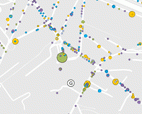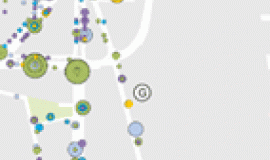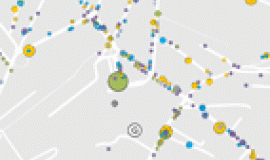
Line 17
A high number of jobs connected with transport
The future Grand Paris Express Line 17 will connect Saint-Denis-Pleyel station with Mesnil-Amelot. The 27 kilometres of the line will have stations in nine neighbourhoods with very different demographic and economic profiles. In 2012, there were 101,000 people employed in the station neighbourhoods along this line, of which three quarters were located at either end of the line, in two terminals (T2 and T4) at Charles de Gaulle Airport and in Saint-Denis-Pleyel, future hub of the Grand Paris Metropolis where Lines 14, 15, 16 and 17 will intersect.
A large number of the jobs in these neighbourhoods are in transport, light industry and support, in particular in the five furthest to the north. The southern section traverses densely populated areas, mostly residential apart from Saint-Denis-Pleyel. This old industrial neighbourhood is undergoing a transformation which began fifteen years ago turning it into a neighbourhood which now has a dense economic fabric with a concentration of jobs for senior executives. These changes will continue together with the RGPE coming into operation and the Olympic village project connected to the Paris bid for the 2024 games.
Line 18
A substantial number of highly skilled jobs and a significant potential for development around the urban campus of Saclay
The future Grand Paris Express Line 18 will connect ten stations of which eight are new, from Versailles Chantiers to Orly Airport. This line, whose route extends the furthest outside the limits of the Grand Paris Metropolis, crosses territories which are not heavily populated but are involved in large projects. There are twice as many jobs than working residents in station neighbourhoods along Line 18. In 2012, only 55,300 salaried employees were working in the ten station neighbourhoods along Line 18 but a high number of these jobs had a high value added factor (a predominance of senior executive posts) and were attached to a “driving force” business such as Renault’s Technocentre in the neighbourhood of Saint-Quentin Est or the Atomic Energy Commissariat in the CEA Saint-Aubin neighbourhood.
The majority of jobs in four neighbourhoods (Satory, Saint-Quentin Est, Antonypôle and Orly Airport) are in manufacturing and transport. In four others there is a substantial number of jobs in public services: higher education in Orsay-Gif and Palaiseau, hospital jobs in Massy-Opéra and a greater diversity of public sector jobs in Versailles Chantiers.
Over the last fifteen years, the focus of the construction industry has been on building places of work, especially offices, in particular in Massy-Palaiseau with the development of the Atlantis district. The specific characteristics of the economic fabric of station neighbourhoods along Line 18 will be consolidated in the coming years by the projects already underway and in particular by the most important of these: the urban campus of the Saclay Plateau which is aiming to become a teaching and research campus of international standing. The three station neighbourhoods principally concerned are Palaiseau, Orsay-Gif and CEA Saint-Aubin.
Studies can be found at:
https://www.apur.org/en/study/economic-fabric-station-neighbourhoods-along-grand-paris-metro-line-17...
https://www.apur.org/en/study/economic-fabric-station-neighbourhoods-along-grand-paris-metro-line-18...
Press contacts:


